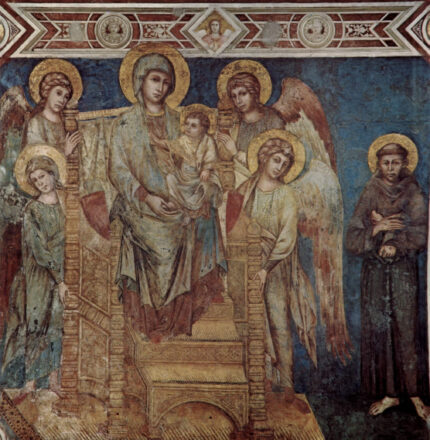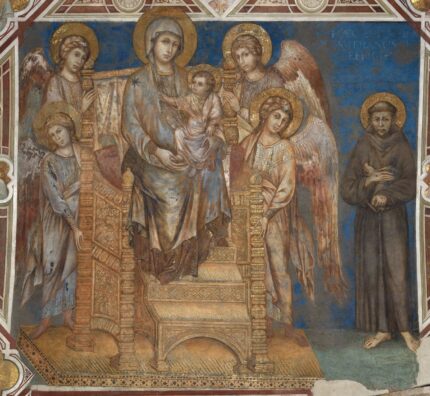A fresco by medieval master Cimabue in the Lower Basilica of St. Francis of Assisi has been restored to rich detail and luminous luster thanks to €300,000 in funding from luxury car manufacturer Ferrari. Our Lady in Majesty, also known as Madonna and Child, Angels and St. Francis, survived the 1997 earthquake that devastated Assisi, causing the collapse of the roof of the adjacent Upper Basilica and claiming the lives of four people.
Located in the northern transept, to the right of the church’s high altar, the Majesty was painted by Cimabue between 1285 and 1290. It is one of his most famous works because it contains one of the oldest portraits of St. Francis. Francis died in 1226. The oldest known depiction of him, a fresco in the Benedictine abbey at Subiaco, was created only two years after his death, but it is an abstract representation in the flat, formal Byzantine style, not an attempt to capture the appearance of the man. Cimabue created an actual portrait of St. Francis reputedly based on descriptions given to him by people who had known Francis personally, so it is the oldest surviving realistic depiction of him. The fresco is also famous for its innovative use of perspective, an important transitional moment between the hieratic Byzantine style and the naturalism that would flourish in the Renaissance.
The Majesty depicts Mary enthroned holding the Christ child on her knee. The throne is surrounded by four angels. To the right is St. Francis bearing the stigmata in his hands. Mary, the Christ child and the angels are idealized representations, serenely beautiful in perfect symmetry. Francis is skinny, his ears stick out (one of them swollen with the mumps) and his heavily lidded eyes have a care-worn expression rather than sublimely serenity of the heavenly countenances.
Restoration work began in January 2023. Conservators from the cultural heritage restoration company Tecnireco first studied the fresco with the latest imaging technology, using x-ray fluorescence and infrared spectroscopy to determine which parts of the fresco were original and which were later additions. The technology also revealed the original pigments used by Cimabue.
Once the analysis was completed, restorers removed thick deposits of atmospheric particles (dust, smoke, grime) and a coat of yellowing protective varnish applied in a 1973 intervention. They then focused on the adhesion of areas of flaking paint and gilding. The plaster layer was also re-adhered to the masonry.
To avoid painting over the original fresco, they replaced pigment that had become detached, especially azurite pigment used for the background, with neutral colours such as grey. “We have taken away all of the additions made over the centuries,” says Fusetti, adding that the painting had now regained its original luminosity. “What we now see is the original work.”
Since the 1997 earthquake, personnel from Tecnireco have been entrusted with cleaning all of the frescoes, which cover a surface area of 10,000 sq. m, once a year. Annual dusting will help keep Maestà di Assisi in good condition, Fusetti says. “We won’t need to restore it for another 60 or 70—maybe even 100—years,” he adds. “Future maintenance will be more affordable as a result.’
The details on the throne look stunning, the inlay highlighted by glowing gilding that you couldn’t see at all before the restoration. St. Francis’ scraggly beard takes on a whole new prominence too.

